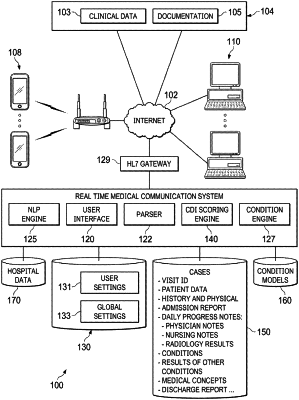| CPC G16H 10/60 (2018.01) [G06F 40/205 (2020.01); G06F 40/242 (2020.01); G06F 40/30 (2020.01); G06N 20/00 (2019.01); G06F 3/0482 (2013.01); G06F 3/0483 (2013.01)] | 20 Claims |

|
1. A method, comprising:
responsive to new data arriving at a data store, processing, by a computer, entities of interest extracted from the new data into concepts specific to a patient;
automatically summarizing, by the computer, the concepts specific to the patient into concept groups, the concept groups indicative of medical conditions of the patient documented at time points during the patient's stay at a facility;
providing, by the computer, the concept groups to non-time-sensitive models and time-sensitive models;
wherein, on a per medical condition basis, a non-time-sensitive machine learning engine applies the non-time-sensitive models to the concept groups across all the medical conditions of the patient and generates an output containing a list of documented medical conditions that the patient likely has during the patient's stay; and
wherein, on a per medical condition basis, a time-sensitive machine learning engine applies the time-sensitive models to the concept groups across the medical conditions of the patient documented within a time period and generates an output containing a running total of documented medical conditions that the patient likely has sufficiently documented during the time period;
comparing, by the computer, the output from the non-time-sensitive machine learning engine and the output from the time-sensitive machine learning engine to identify any medical condition of the patient that is identified by the non-time-sensitive machine learning engine as having been documented during the patient's stay, but that is not identified by the time-sensitive machine learning engine as having been sufficiently documented during the time period, indicating that a documentation drop-off (DDO) has occurred; and
generating, by the computer, a notification that the DDO has occurred.
|